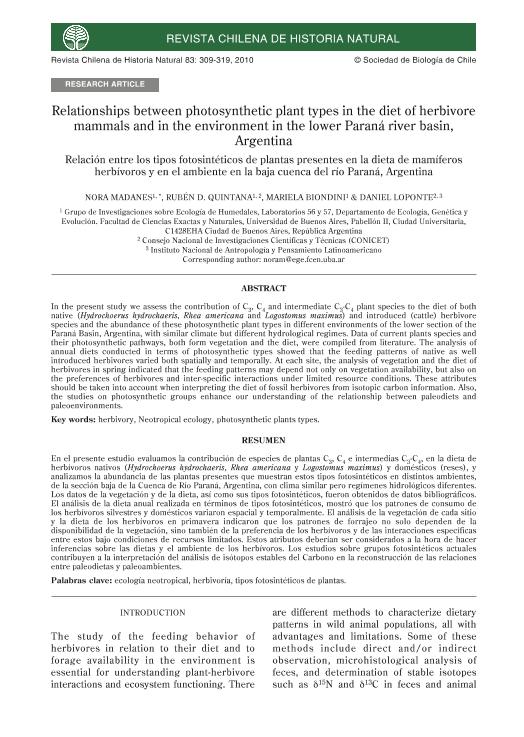Mostrar el registro sencillo del ítem
dc.contributor.author
Madanes, Nora

dc.contributor.author
Quintana, Ruben Dario

dc.contributor.author
Biondini, Mariela

dc.contributor.author
Laponte, Daniel
dc.date.available
2023-03-27T20:15:02Z
dc.date.issued
2010-04
dc.identifier.citation
Madanes, Nora; Quintana, Ruben Dario; Biondini, Mariela; Laponte, Daniel; Relationships between photosynthetic plant types in the diet of herbivore mammals and in the environment in the lower Paraná river basin, Argentina; Sociedad de Biología de Chile; Revista Chilena de Historia Natural; 83; 2; 4-2010; 309-319
dc.identifier.issn
0716-078X
dc.identifier.uri
http://hdl.handle.net/11336/191743
dc.description.abstract
In the present study we assess the contribution of C3, C4 and intermediate C3-C4 plant species to the diet of both native (Hydrochoerus hydrochaeris, Rhea americana and Logostomus maximus) and introduced (cattle) herbivore species and the abundance of these photosynthetic plant types in different environments of the lower section of the Paraná Basin, Argentina, with similar climate but different hydrological regimes. Data of current plants species and their photosynthetic pathways, both form vegetation and the diet, were compiled from literature. The analysis of annual diets conducted in terms of photosynthetic types showed that the feeding patterns of native as well introduced herbivores varied both spatially and temporally. At each site, the analysis of vegetation and the diet of herbivores in spring indicated that the feeding patterns may depend not only on vegetation availability, but also on the preferences of herbivores and inter-specific interactions under limited resource conditions. These attributes should be taken into account when interpreting the diet of fossil herbivores from isotopic carbon information. Also, the studies on photosynthetic groups enhance our understanding of the relationship between paleodiets and paleoenvironments.
dc.description.abstract
En el presente estudio evaluamos la contribución de especies de plantas C3, C4 e intermedias C3-C4, en la dieta de herbívoros nativos (Hydrochoerus hydrochaeris, Rhea americana y Logostomus maximus) y domésticos (reses), y analizamos la abundancia de las plantas presentes que muestran estos tipos fotosintéticos en distintos ambientes, de la sección baja de la Cuenca de Río Paraná, Argentina, con clima similar pero regímenes hidrológicos diferentes. Los datos de la vegetación y de la dieta, así como sus tipos fotosintéticos, fueron obtenidos de datos bibliográficos. El análisis de la dieta anual realizada en términos de tipos fotosintéticos, mostró que los patrones de consumo de los herbívoros silvestres y domésticos variaron espacial y temporalmente. El análisis de la vegetación de cada sitio y la dieta de los herbívoros en primavera indicaron que los patrones de forrajeo no solo dependen de la disponibilidad de la vegetación, sino también de la preferencia de los herbívoros y de las interacciones específicas entre estos bajo condiciones de recursos limitados. Estos atributos deberían ser considerados a la hora de hacer inferencias sobre las dietas y el ambiente de los herbívoros. Los estudios sobre grupos fotosintéticos actuales contribuyen a la interpretación del análisis de isótopos estables del Carbono en la reconstrucción de las relaciones entre paleodietas y paleoambientes.
dc.format
application/pdf
dc.language.iso
eng
dc.publisher
Sociedad de Biología de Chile

dc.rights
info:eu-repo/semantics/openAccess
dc.rights.uri
https://creativecommons.org/licenses/by/2.5/ar/
dc.subject
HERBIVORY
dc.subject
NEOTROPICAL ECOLOGY
dc.subject
PHOTOSYNTHETIC PLANTS TYPES
dc.subject.classification
Ecología

dc.subject.classification
Ciencias Biológicas

dc.subject.classification
CIENCIAS NATURALES Y EXACTAS

dc.title
Relationships between photosynthetic plant types in the diet of herbivore mammals and in the environment in the lower Paraná river basin, Argentina
dc.title
Relación entre los tipos fotosintéticos de plantas presentes en la dieta de mamíferos herbívoros y en el ambiente en la baja cuenca del río Paraná, Argentina
dc.type
info:eu-repo/semantics/article
dc.type
info:ar-repo/semantics/artículo
dc.type
info:eu-repo/semantics/publishedVersion
dc.date.updated
2023-03-23T12:18:12Z
dc.identifier.eissn
0717-6317
dc.journal.volume
83
dc.journal.number
2
dc.journal.pagination
309-319
dc.journal.pais
Chile

dc.description.fil
Fil: Madanes, Nora. Universidad de Buenos Aires. Facultad de Ciencias Exactas y Naturales. Departamento de Ecología, Genética y Evolución; Argentina
dc.description.fil
Fil: Quintana, Ruben Dario. Consejo Nacional de Investigaciones Científicas y Técnicas; Argentina. Universidad de Buenos Aires. Facultad de Ciencias Exactas y Naturales. Departamento de Ecología, Genética y Evolución; Argentina
dc.description.fil
Fil: Biondini, Mariela. Consejo Nacional de Investigaciones Científicas y Técnicas; Argentina. Universidad de Buenos Aires. Facultad de Ciencias Exactas y Naturales. Departamento de Ecología, Genética y Evolución; Argentina
dc.description.fil
Fil: Laponte, Daniel. Secretaría de Cultura de la Nación. Dirección Nacional de Cultura y Museos. Instituto Nacional de Antropología y Pensamiento Latinoamericano; Argentina
dc.journal.title
Revista Chilena de Historia Natural

dc.relation.alternativeid
info:eu-repo/semantics/altIdentifier/url/http://rchn.biologiachile.cl/es/contents/2010v83n2.php
dc.relation.alternativeid
info:eu-repo/semantics/altIdentifier/url/https://www.scielo.cl/scielo.php?pid=S0716-078X2010000200011&script=sci_abstract&tlng=en
Archivos asociados
